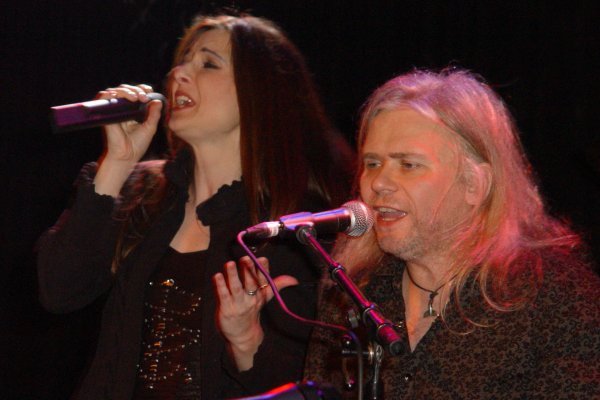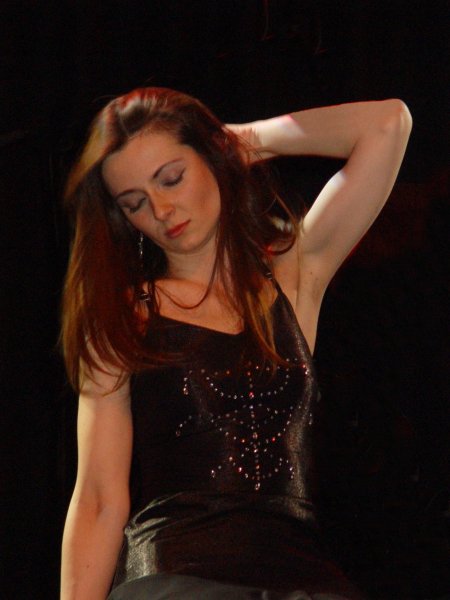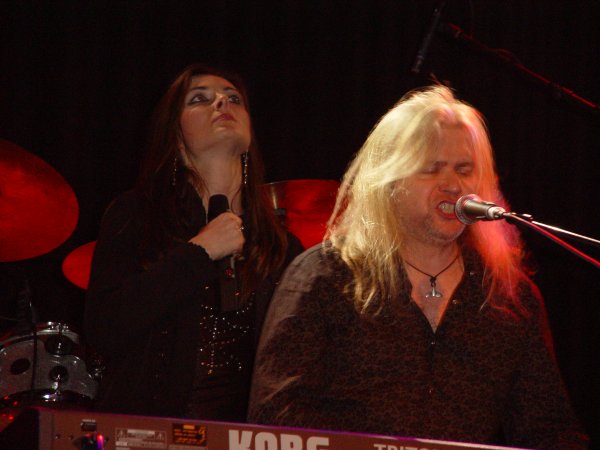|
THE STORY BEHIND... Caamora “I carried the story in my mind since my childhood” (July 2010, text by Henri Strik, edited by Peter Willemsen, live pictures by Arthur Haggenburg) 
One of the most ambitious and difficult projects that keyboard wizard Clive Nolan worked on was without any doubt the musical rock opera She. It cannot be compared to any project he did before with Pendragon, Arena, Shadowland or Strangers On A Train. Of course, we are very curious to know what the maestro himself has to tell about the Caamora project. What was the reason to start Caamora and She? “I’ve always wanted to write a musical rock opera and She was a story which I carried in my mind since my childhood. I just needed the right opportunities and the right circumstances.”Why did you choose a novel written by H. Rider Haggard? “I first encountered the story of She at the cinema as a young child. The adventure and the themes intrigued me and the tragic finale gave me nightmares for weeks afterwards. There was something about the story, something about the period, the corruption of immortality and the fears that haunts our darkest thoughts, which drew me to this tale. Not long after seeing the film, I read the book and in many ways, this was a life changing moment. Anyone who is familiar with my bands and my previous releases will probably be able to find many references to fire, immortality and corruption.”Can you explain the story of She in a few lines? “In my version, two explorers travel to darkest Africa in search of the source of a legend. Ayesha, the queen of a lost tribe, is believed to be immortal, but of course, such things cannot exist. The explorers, Leo and Holly, eventually find themselves in the city of the lost tribe and meet the mysterious queen. It transpires that Ayesha has been waiting for 2000 years for her dead lover to return and she believes this man to be Leo. Despite the warnings from the native girl Ustane, who has befriended the explorers, Leo is intoxicated by Ayesha’s will. The queen will let nothing stand in her way and she murders Ustane in a moment of anger before showing the explorers the secret of her immortality, the fire of life deep in the heart of a nearby volcano. Ayesha is keen to persuade Leo to join her in the fire so they can share eternity together, ruling over the lost tribe and possibly over the world. As Leo hesitates, something terrible happens: Ayesha begins to age! The 2000 years are returned to her by the fire and with a last gasp she beseeches Leo to wait for her to return…”Would you call She a rock opera or a musical? “I believe that the term ‘rock opera’ has become rather over used. Many albums recently emerged claim to fulfil this genre merely because there is a consistent theme to the album and more than one singer. I set out to write a musical version of a story that could be performed theatrically. It is probably easiest to call this a rock opera in many ways; I just call it an opera.Why did it become a double album containing two hours of music? You once told me that an album should last no longer than 60 minutes. When it gets longer, people are loosing interest, which should be the reason why you hardly ever listen to the last parts of albums like The Lamb, The Wall or Subterranea. “Yes, that is true, I don’t, but I do listen to operas and musicals. I wrote She to be a theatrical experience. Two hours is a standard amount of time for such a work. However, if this seems to daunting, I suggest you listen to the first CD on one day and save the second one for the next day. Another point worth noting is that these double concept albums are written and performed by a band. That implies a reasonably consistent style, sound and structure throughout, thus making it harder to maintain a level of interest. A musical or rock opera is a much wider musical landscape, so I think it can maintain the listener’s interest more successfully.”
How did you meet Agnieszka Swita and was it difficult to get the other people for the vocal parts? I met Agnieszka purely by coincidence. A mutual friend of ours was visiting the U.K., so I invited her over for dinner and she brought her friend, Agnieszka. When I met her, the whole She thing came flooding to the front of my mind and I started to tell her about my longstanding wish to write a theatrical work. She was enthusiastic towards my ideas and within a few weeks, we recorded the first demo, which turned out to be the overture for She. Alan Reed was an obvious choice for the part of Holly due to his theatrical style of performance and his gritty voice. Actually, it was Alan, who recommended Christina Booth to me. That proved to be an excellent choice.Why did you yourself take a role as one of the characters in the story? “I always enjoyed singing from the days of Shadowland and over the years I did a lot of singing in the studio, but usually backing vocals. I performed a Shadowland song in Poland with NEO and the reactions really amazed me. This made me want to do more. When I was writing the demos, the part of Leo always looked as if it would be minor, so I thought it would be fun to do it myself.”How do you think as a composer and producer about the results of the project? Did they meet the expectations you had in mind? “In many ways the results were greater than I had expected. Early on in the writing stage, I had accepted the idea that a live performance of She would never be more than a simple concert performance. Gradually, as time went on, Metal Mind Records encouraged a leaning towards the more theatrical so by the time we actually performed the show in Katowice in Poland, it was quite a production! The organization and logistics of this certainly were an enormous challenge. I can say without a doubt that She is the biggest undertaking I’ve ever embarked upon.”It surprised me that the music you wrote for She didn’t sound like anything else you did before. Bravo! Did you plan it that way right from the start? “Writing She over the last few years has been the most inspiring period for me. I have been waiting to write this for so long. It felt as if the music was simply waiting for me to find. In many ways, this is probably the most honest music for me because it was not co-written or intended to fit any band parameters.”Was it difficult to perform the whole piece on a live stage and how often did you rehearse the music?  “Yes, it was
difficult. Just the logistics of fitting so many people on stage was quite a
challenge. Rehearsal was minimal due to the involvement of so many musicians
and singers. We rehearsed for two days in the U.K. with the core of the band
and then we flew to Poland for another two days of rehearsals adding the choir
and the Polish musicians. During these two days, we also had to acquaint
ourselves with in-ear-monitoring and head mikes, as well as costume, props and
scenery. The simple task of fitting all the musicians on stage as well as ‘choreographing’
the movements of the singers and the choir was complex and demanding. We
actually had only one proper dress rehearsal on the morning of the show and
because of technical problems and timings, we only ran the first act, so there
was a lot of tension on the night of the show, but fortunately it went well.”
“Yes, it was
difficult. Just the logistics of fitting so many people on stage was quite a
challenge. Rehearsal was minimal due to the involvement of so many musicians
and singers. We rehearsed for two days in the U.K. with the core of the band
and then we flew to Poland for another two days of rehearsals adding the choir
and the Polish musicians. During these two days, we also had to acquaint
ourselves with in-ear-monitoring and head mikes, as well as costume, props and
scenery. The simple task of fitting all the musicians on stage as well as ‘choreographing’
the movements of the singers and the choir was complex and demanding. We
actually had only one proper dress rehearsal on the morning of the show and
because of technical problems and timings, we only ran the first act, so there
was a lot of tension on the night of the show, but fortunately it went well.” I heard that you are planning to bring the whole show to Broadway and maybe into the main theatres in Europe. Am I right? “That would be wonderful! I would love to do this, but there are no plans or opportunities in place at the moment.” You did the first release of the Caamora project under your own name. Why? “We agreed with Metal Mind that the Caamora name would only be used in conjunction with them. Agnieszka and I made the first EP ourselves so we avoided using Caamora. After that Metal Mind made everything else.”Did you re-record the songs from the CD singles you used on the She-album, or are those versions identical?  “From the Closer EP two songs were used on
She, The Bonding
and Closer,
both of which were re-recorded. From the Walk
On Water EP I used only Shadows.
We kept most of the drums, but re-recorded everything else. On the
Embrace EP, the title track is from the
studio album, but with a new vocal performance from Agnieszka.
Resting Place is from the studio album and
The Eleventh Hour is from the live version,
but a different mix.”
“From the Closer EP two songs were used on
She, The Bonding
and Closer,
both of which were re-recorded. From the Walk
On Water EP I used only Shadows.
We kept most of the drums, but re-recorded everything else. On the
Embrace EP, the title track is from the
studio album, but with a new vocal performance from Agnieszka.
Resting Place is from the studio album and
The Eleventh Hour is from the live version,
but a different mix.” On the mentioned CD singles of Closer and Walk On Water, you used old songs from Shadowland and Strangers On A Train. Why did you do that? Do they sound stronger than the original pieces? “We just used old songs to offer people different flavours of the music that we were making in conjunction with Agnieszka’s voice. Personally, I really like these new versions, particularly Walk On Water.”Why did you use the name Caamora for this project? “Caamora comes from a set of fantasy novels called ‘The Chronicles of Thomas Covenant’ by author Stephen Donaldson. It is a fictional word to describe a ritual, which was the spiritual act of cleansing by fire.”What happens with the bands that fit your other musical ideas such as Arena, Shadowland and Strangers On A Train? “Now that She is written and in fact released, I have an opportunity to refocus my mind onto some of the other bands and projects again. I’ve already begun writing the next Arena album.”Thanks for your time, Clive! “Thanks very much for the interview!”More info: http://www.caamora.net http://www.metalmind.com.pl |